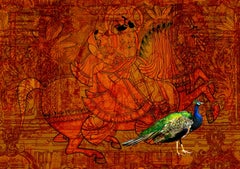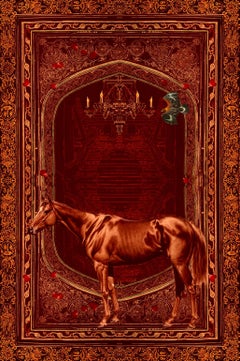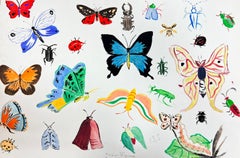Srinivas Pulagam Paintings
to
2
Overall Width
to
Overall Height
to
2
2
1
1
2
1
1
1
1
1
1
1
1
2
2
2
2
2
781
718
706
691
Artist: Srinivas Pulagam
Uncounted Remembrance, Watercolour & Gouache on Paper by Indian Artist"In Stock"
By Srinivas Pulagam
Located in Kolkata, West Bengal
Srinivas Pulagam - Uncounted Remembrance - 28 x 40 inches ( without framing )
Watercolour & Gouache on Paper
Inclusive of shipment in roll form.
Academic Background :
B.F.A (painti...
Category
2010s Contemporary Srinivas Pulagam Paintings
Materials
Paper, Watercolor, Gouache
Empire, Watercolour & Gouache on Paper, Brown by Indian Artist "In Stock"
By Srinivas Pulagam
Located in Kolkata, West Bengal
Srinivas Pulagam - Empire - 28 x 40 inches ( without framing )
Watercolour & Gouache on Paper
Inclusive of shipment in roll form.
Academic Background :
B.F.A (painting)Andhra unive...
Category
2010s Contemporary Srinivas Pulagam Paintings
Materials
Paper, Watercolor, Gouache
Related Items
Mid Century French Illustration Sketches Of Different Butterflies & Insects
By Josine Vignon
Located in Cirencester, Gloucestershire
Butterflies
by Josine Vignon (French 1922-2022)
signed
pastel/watercolor on paper, unframed
painting: 13 x 19 inches
good condition
provenance: from the artists estate, France
Josi...
Category
Mid-20th Century Post-Impressionist Srinivas Pulagam Paintings
Materials
Oil Pastel, Watercolor
$140 Sale Price
30% Off
H 13 in W 19 in D 1 in
Oil Painting On Canvas. A French Bulldog On An Abstract Green Background.
Located in Bogotá, Bogotá
Oil painting of a forgotten French bulldog, set against an abstract background dominated by Veronese green with touches of gold leaf. Made with professional Rembrandt colors. For dur...
Category
2010s Contemporary Srinivas Pulagam Paintings
Materials
Gold
$448 Sale Price
20% Off
H 27.56 in W 27.56 in
Antique oil painting, Boy Fleaing a Dog, Gerard ter Borch, Dutch golden age
Located in DEVENTER, NL
Gerard ter Borch (II) (1617-1681), copy after, around 1700
'Boy Fleas a Dog'
Oil on canvas
Professionally restored (cleaned and relined)
In modern frame in 17th century style
Dimensions excl. frame: 33 x 27,5 cm.
Dimensions incl. frame: approx. 50 x 45,5 cm.
Depcited is a boy busy fleaing a dog. The boy sits on a chair with the dog on his lap. On a table on the right there is a book and a pen. On a wooden bench lies the boy's hat.
What is unique about this painting by Ter Borch, is the relationship that is depicted between human and animal. Mostly animals like dogs where depicted as an attribute in paintings in the 17th century, and sometimes used to symbolize certain character traits. This boy is lovingly caring for his dog, which he is giving his full attention.
Another interesting detail is that Ter Borch's brother Moses, was probably the model for this painting. Ter borch often used family members as models for his paintings. Moses was also a very talented painter and draughtsman.
Several copies of this work by Ter Borch are known. One of these copies is in the collection of the Dutch Rijksmuseum (Image included in the image gallery (last image)).
The original painting is in the collection of the Alte Pinakothek museum in Munich, Germany.
Gerard ter Borch, also known as Gerard Terburg, was a Dutch genre painter who lived in the Dutch Golden Age. He influenced fellow Dutch painters Gabriel Metsu...
Category
Early 18th Century Old Masters Srinivas Pulagam Paintings
Materials
Canvas, Oil
$3,556 Sale Price
20% Off
H 19.69 in W 17.92 in
Drawer of illusions. 2025 cardboard, canvas, oil, 50x70 cm
By Juris Dimiters
Located in Riga, LV
Juris Dimiters is among the most intellectual and witty artists of his generation. The characters of his works – paintings and posters – mostly are anthropomorphized fruits and objec...
Category
2010s Contemporary Srinivas Pulagam Paintings
Materials
Canvas, Oil, Cardboard
$1,707 Sale Price
20% Off
H 19.69 in W 27.56 in D 1.19 in
Antique oil painting on panel, interior scene with a cat, Belgium, 19th century
Located in DEVENTER, NL
Franciscus Melzer (1808-1865)
Interior painting with a cat that gives out a scratch
Signed lowerright corner F. Melzer
Oil on mahogany wooden pane...
Category
19th Century Flemish School Srinivas Pulagam Paintings
Materials
Oil, Wood Panel
$4,149
H 24.41 in W 29.14 in
Archie
By Vera Barnett
Located in Dallas, TX
Vera Barnett is best known for creating elements of her composition—by sewing and painting plastic, building objects with cardboard and tape, and assembling found objects—then settin...
Category
2010s Contemporary Srinivas Pulagam Paintings
Materials
Linen, Oil
'The Departure of the Israelites from Egypt' by Frans Francken the Younger
Located in Knokke, BE
Frans Francken the Younger
1581 - Antwerp - 1642
Flemish Painter
'The Departure of the Israelites from Egypt – The Exodus', c. 1610 - 1620
Medium: pen in sepia on paper
Dimensions: mage size 26 x 34,5 cm, frame size 55 x 65,5 cm
Biography: Frans Francken the Younger, born in Antwerp in 1581 and passing away on May 6, 1642, also in Antwerp, was a distinguished Flemish painter. He is recognized as the most prominent and productive member of the renowned Francken family of artists. Francken explored a wide range of subjects, creating large altarpieces for churches and producing smaller works depicting historical, mythological, and allegorical scenes. Notably, his depictions of collectors’ cabinets established a popular new genre of art during his era. He was known for collaborating with other artists, enriching their works with his skilled renderings of figures and narrative elements, complementing specialists in landscape, architectural scenes, and floral still-life painting.
Francken was born to Frans Francken the Elder and Elisabeth Mertens. His father was a pupil of Antwerp’s leading history painter, Frans Floris, and a significant creator of altarpieces in Flanders during his time. Francken received his artistic training under the guidance of his father. Additionally, it is possible that Frans and his brother, Hieronymus Francken II, received further instruction in the workshop of their uncle, Hieronymus Francken I, in Paris.
A versatile artist, Francken made significant contributions to various genres within Flemish art, introducing new themes and subjects. Many of his works comprised small-scale historical, allegorical, and biblical cabinet paintings, often emphasizing figures. He is credited with either inventing or popularizing several novel themes that gained popularity in Flemish painting, including genre scenes featuring monkeys (also known as singeries) and Kunstkammer or gallery paintings, presenting a plethora of natural and artistic treasures against a neutral wall. Francken introduced various other unconventional themes that later gained traction, such as the ‘Triumphal Procession of Amphitrite’ and ‘Croesus and Solon.’ He also produced a series of paintings depicting witches and witchcraft, including portrayals of witches’ sabbats.
His remarkable paintings are held in the collections of numerous major museums throughout Europe. Francken specialized in rendering the human figure, as evidenced by etched and engraved portraits of the artist by Anthony van Dyck (after Peter Paul Rubens), identifying him with the Latin inscription: ‘ANTVERIÆ PICTOR HVMANARVM FIGVRARVM’ (Figure painter of Antwerp). He was frequently invited to contribute figures to compositions by other esteemed artists, including landscape artists such as Tobias Verhaecht, Abraham Govaerts, and Joos de Momper...
Category
Early 17th Century Baroque Srinivas Pulagam Paintings
Materials
Pen, Paper
$19,917
H 21.66 in W 25.79 in D 1.58 in
"Urban Zoo" Oil painting
By Louis Recchia
Located in Denver, CO
Louis Recchia's (US based) "Urban Zoo" is an oil painting that depicts a lama, giraffes, and a whale in a surreal urban environment
Louis Recchia has been producing contemporary ar...
Category
2010s Surrealist Srinivas Pulagam Paintings
Materials
Canvas, Oil
A Woeful Companion
By Arthur Batt
Located in Belgravia, London, London
Oil on canvas
Canvas size: 27 x 24 inches
Framed size: 33 x 30.5 inches
Signed and date '87 lower left
Category
19th Century Srinivas Pulagam Paintings
Materials
Canvas, Oil
Il Consiglio del Re - contemporary interior horse Oil Painting board
By Ellie Hesse
Located in London, GB
Ellie Hesse was born in New York in 1972 but spent most of her childhood in the Yorkshire Dales. Travel has always been an important feature of her life since then, exploring Asia an...
Category
2010s Contemporary Srinivas Pulagam Paintings
Materials
Oil, Canvas
$2,349
H 37.41 in W 39.38 in D 1.58 in
"La Chevauchèe des Couleurs", Jean-Claude Gaugy, Oil on Board, Contemporary
Located in Dallas, TX
"La Chevauchèe des Couleurs" is an original oil on board painting that measures 30x40 inches and comes unframed. Gaugy uses his textured lines and hues o...
Category
2010s Contemporary Srinivas Pulagam Paintings
Materials
Oil, Board
$16,500
H 30 in W 40 in D 1 in
"Family Unit" Oil painting
By Louis Recchia
Located in Denver, CO
Louis Recchia's (US based) "Family Unit" is an oil painting that depicts a family of felines personified in interior setting with birds
Louis Recchia has been producing contemporary...
Category
2010s Impressionist Srinivas Pulagam Paintings
Materials
Canvas, Oil
Srinivas Pulagam paintings for sale on 1stDibs.
Find a wide variety of authentic Srinivas Pulagam paintings available for sale on 1stDibs. If you’re browsing the collection of paintings to introduce a pop of color in a neutral corner of your living room or bedroom, you can find work that includes elements of red and other colors. You can also browse by medium to find art by Srinivas Pulagam in gouache, paint, paper and more. Much of the original work by this artist or collective was created during the 21st century and contemporary and is mostly associated with the contemporary style. Not every interior allows for large Srinivas Pulagam paintings, so small editions measuring 36 inches across are available. Srinivas Pulagam paintings prices can differ depending upon medium, time period and other attributes. On 1stDibs, the price for these items starts at $2,970 and tops out at $2,970, while the average work can sell for $2,970.


